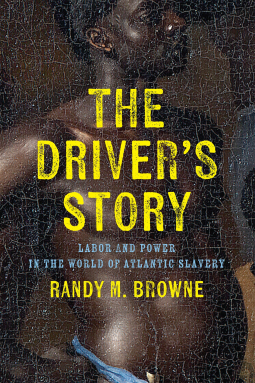
The Driver's Story
Labor and Power in the World of Atlantic Slavery
by Randy M. Browne
This title was previously available on NetGalley and is now archived.
Send NetGalley books directly to your Kindle or Kindle app
1
To read on a Kindle or Kindle app, please add kindle@netgalley.com as an approved email address to receive files in your Amazon account. Click here for step-by-step instructions.
2
Also find your Kindle email address within your Amazon account, and enter it here.
Pub Date May 07 2024 | Archive Date Apr 09 2024
Talking about this book? Use #TheDriversStory #NetGalley. More hashtag tips!
Description
The story of the driver is the story of Atlantic slavery. Starting in the seventeenth-century Caribbean, enslavers developed the driving system to solve their fundamental problem: how to extract labor from captive workers who had every reason to resist. In this system, enslaved Black drivers were tasked with supervising and punishing other enslaved laborers. In The Driver’s Story, Randy M. Browne illuminates the predicament and harrowing struggles of these men—and sometimes women—at the heart of the plantation world. What, Browne asks, did it mean to be trapped between the insatiable labor demands of white plantation authorities and the constant resistance of one’s fellow enslaved laborers?
In this insightful and unsettling account of slavery and racial capitalism, Browne shows that on plantations across the Americas, drivers were at the center of enslaved people’s working lives, social relationships, and struggles against slavery. Drivers enforced labor discipline and confronted the resistance of their fellow enslaved laborers, aiming to maintain a position that helped them survive in a world where enslaved people were treated as disposable. Drivers also protected the people they supervised, negotiating workloads and customary rights to essentials like food and rest with white authorities. Within the slave community, drivers helped other enslaved people create a sense of belonging, as husbands and fathers, as Big Men, and as leaders of diasporic African “nations.” Sometimes, drivers even organized rebellions, sabotaging the very system they were appointed to support.
Compelling and original, The Driver’s Story enriches our understanding of the never-ending war between enslavers and enslaved laborers by focusing on its front line. It also brings us face-to-face with the horror of capitalist labor exploitation.
Randy M. Browne is Associate Professor of History at Xavier University and author of Surviving Slavery in the British Caribbean, also available from the University of Pennsylvania Press.
Advance Praise
"This utterly captivating and unflinching book leads readers deep into the driver's challenging world. It provides an unusually close-up view of enslaved people's daily lives as they faced their enslavers and each other. Indispensable to anyone interested in slavery, colonialism, and racial capitalism."—Marjoleine Kars, author of Blood on the River: A Chronicle of Mutiny and Freedom on the Wild Coast
"Browne’s vital book does three things extremely well. It makes an important argument about the centrality of drivers to the functioning of plantation capitalism and the social and political lives of the enslaved. It offers a penetrating analysis of the existential predicament of people who became drivers. Finally, it presents a highly readable story about one of the most vexing topics in human history: oppressed oppressors. The Driver’s Story will occupy a significant place in the historiography of slavery."—Vincent Brown, author of Tacky’s Revolt: The Story of an Atlantic Slave War
"In his impressive, deeply researched book, Randy M. Browne helps us to understand driving as a practice throughout Caribbean plantation slave societies, while grounding his analysis in specific lives and places. Drivers, Browne shows us, lived a ‘nightmare’ in which they were terrorized into terrorizing others, leading to deep damage to them even while they reaped some tangible material rewards. Browne’s insights, particularly into the politics of drivers and the development of rebellions, will surely be influential in future scholarship."—Diana Paton, author of The Cultural Politics of Obeah: Religion, Colonialism and Modernity in the Caribbean World
Available Editions
| EDITION | Hardcover |
| ISBN | 9781512825862 |
| PRICE | $39.95 (USD) |
| PAGES | 224 |
Available on NetGalley
Featured Reviews
 Kevin H, Reviewer
Kevin H, Reviewer
Eye-opening and well researched, Browne details the horrific use of the driver system in institutions of slavery. With analysis of the driving system and many different accounts from and about drivers, we get an in-depth study of a fundamental aspect of slavery that is often overlooked. I learned a lot from this book, but wanted more fleshed out stories from the many examples he used; the rebellion of 1814 being the most described account, it felt choppy split up amongst other examples and its varied analysis. Despite at times being dry and repetitive, this book is fascinating and well worth reading.
Thank you Randy M. Browne, University of Pennsylvania Press, and NetGalley for the ARC.
 Anita S, Librarian
Anita S, Librarian
As the author elucidates, the subject matter of this book shares a problem all historians of slavery face in “trying to recover enslaved people’s experiences.” As the majority of records in which enslaved people appear were produced by “slave owners, merchants, and governments for their own purposes,” the archives of Atlantic slavery, “were not generally designed to document enslaved people’s own perspectives or voices.” Because of this, the records that have survived offer “fleeting, fragmentary, and distorted glimpses of enslaved people’s lives.”
The author had to go to archives in Guyana, Cuba, and the United Kingdom as well as United States.
Focusing on slave drivers and their role on plantations across the United States as well as parts of the Caribbean, the author further identified an issue of the absence of female drivers. “While enslaved men served as drivers more often than enslaved women, something like a quarter of all drivers in the Caribbean may have been women. Enslaved women were especially prominent as drivers of specialized ‘children’s gangs,’ but they also sometimes supervised adult field laborers.” As a result, the author found only a “handful” of enslaved women identified as drivers, so they expanded their search to places that would enable a broader understanding of the role and experiences of such women.
Readers will learn about horrifying methods at the heart of violence inflicted in chattel slavery, including tally sticks. As the author expands, “[b]y the early nineteenth century, enslaved drivers in the Caribbean used wooden tallies to keep track of the work performed by the field laborers they supervised. At regular intervals, white plantation authorities inspected those tally sticks to see if drivers were pushing the people below them to work as hard as they demanded When tallies indicated that drivers fell short, the consequences could be brutal.”
In those cases when a white overseer, for instance, felt that the slave driver had not inflicted enough punishments onto the other enslaved people, the driver was ordered to be flogged.
Readers will also discover how the system of slave drivers was developed, tied directly to the expansion of sugar plantations in the 17th century English Caribbean, then gradually to plantations throughout the Americas until South Carolina.
In Haiti, slave drivers were referred to as ‘commandeurs.’ As the text goes on, the author explains that there was not just one slave driver on a plantation but multiple slave drivers, which created a hierarchy of the ‘head’ driver. Plantation owners also had female drivers they designated to ‘supervise’ enslaved children on the plantation and to threaten them with the fear of physical violence if they ‘disobeyed.’ Although enslaved women were used in this capacity toward children, they would also sometimes be assigned to be drivers in charge of adult ‘laborers.’ This is made more complicated by the fact that many white plantation authorities “refused to acknowledge female drivers in many of the records they created.” Despite this, they saw ample evidence that enslaved women could be used or forced into the role of driver as well as men.
Through records such as those of Henry Whiteley, an English newcomer who traveled to Jamaica in 1832, wanting to find work as a plantation ‘book-keeper’ or junior overseer, the conditions of slave driving become visible in the historical record, in all their horrifying details. The violence, however, was not indiscriminate — drivers targeted people who ‘posed direct threats to production, including those who failed to adhere to work schedules’ or those woh did not complete the amount of work that was expected of them, or did ‘sloppy work.’
Enslaved people were expected to be in the fields, which the author reminds readers, were sometimes miles away and not in close proximity to slave cabins, as films and television shows have popularized, and were expected to be ready to work by as early as 5 or 6am. The slave drivers enforced roll calls. If anyone was late, they could be whipped or punished and if found absent, faced the prospect of more severe consequences. This applied to enslaved women who had just given birth in many cases or were still nursing infants. Pregnant women also suffered significant physical abuse if drivers felt they were late or ‘not doing enough.’
Overall, readers will be able to fill in all the gaps in their knowledge about who slave drivers were on plantations, their roles, how they functioned, and so much more. This book is an essential resource for dispelling the myths about drivers, and nudging the reader to go past simple assumptions like “Oh, they had no choice because the master said so” or “Oh, the master offered them better clothes and more trips off the plantation if they agreed to do this.” Those factors are part of what drivers did and some of the motivation, but the truth and the full historical record requires so much more examination, which this book is an essential resource for.
 Media/Journalist 1206142
Media/Journalist 1206142
This is a well researched description of a little known aspect of plantation governance. The author provides insight into plantation management with its complexities, brutality and violence. The Driver, male and female, assured production by his/her gangs. Browne provides a complete picture of how the work was done and the inhumanity of the process. He also offers a view of the cultural influences from Africa that supported the concept of the "Big Man.." This book is very well written and easy to follow.
 Media/Journalist 1239614
Media/Journalist 1239614
The Driver's Story" serves as a powerful reminder of the enduring legacy of slavery, echoing through generations and shaping the socio-economic structures of the present day. By shedding light on this often-overlooked aspect of history, the book invites readers to confront uncomfortable truths and reckon with the ongoing ramifications of past injustices.
In sum, "The Driver's Story" is a poignant and illuminating work that illuminates the complexities of Atlantic slavery through the lens of the driving system. It is a testament to the resilience of the human spirit and a call to action for a more just and equitable future.
Browne's work, which exposes the horrifying use of the driver system in slave facilities, is insightful and meticulously studied. We receive a thorough examination of a crucial but frequently disregarded facet of slavery through examination of the driving system and a wide range of testimonies from and about drivers. I learnt a lot from this book, but I wish he had included more in-depth narratives for the numerous instances he used. The 1814 insurrection, for example, was the most well-described, but it felt choppy to be divided up amongst so many other cases and points of view.
Incredibly well researched but very hard to read because it’s dense and repetitive. I would have enjoyed the executive summary.
With these topics and stories - I lit a candle and said prayers to the ancestors before diving in. This novel examines the "Big Men" (and sometimes women) - the enslaved Black drivers tasked to extract and maximize labor/production from other enslaved captives, who overtly and covertly resisted at all levels all the time. Some were enforcers, others protectors, some even organized rebellions -- but like other captives, they conformed to survive. Although told from the driver's point of view, it didn't make it easier to digest -- the "driving" business remained consistent despite locale (the Caribbean, the Americas, etc) and took its toll emotionally, mentally, and physically on all involved -- for more than 300 years. As a person of AA descent, parts were difficult to read but this work is important, insightful and informative as examined how driver's negotiated the balance of building their families, appeasing the white plantation owners, negotiated rebellions, etc.
 Mateus O, Reviewer
Mateus O, Reviewer
A very solid contribution to the studies of Atlantic slavery, telling the story of the driver through his interaction with the plantations. Very well written, the book brings us not only the factual history, but also the social relations of power inside the structure of the plantations through the entire America.
Readers who liked this book also liked:
Patti Callahan Henry
General Fiction (Adult), Historical Fiction, Women's Fiction
Jodi Picoult; Jennifer Finney Boylan
General Fiction (Adult), Literary Fiction, Women's Fiction
Katie Churchill-King
General Fiction (Adult), Historical Fiction, History


















